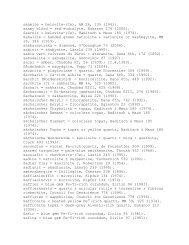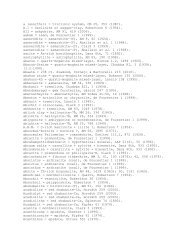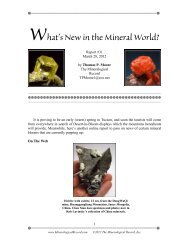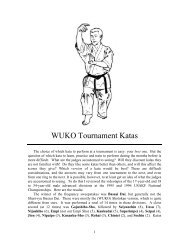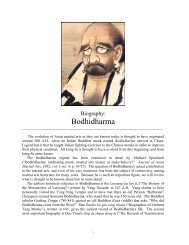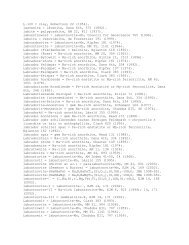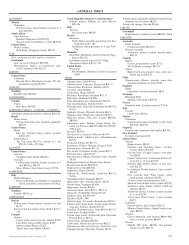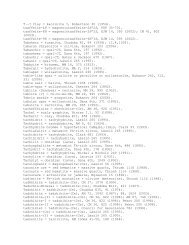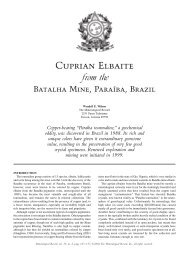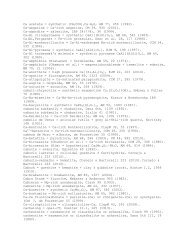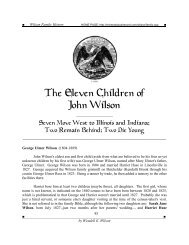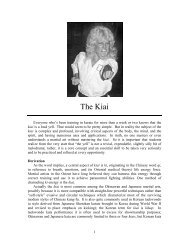Chapter 21: Ancestry of Eugenia Weinbrenner
Chapter 21: Ancestry of Eugenia Weinbrenner
Chapter 21: Ancestry of Eugenia Weinbrenner
Create successful ePaper yourself
Turn your PDF publications into a flip-book with our unique Google optimized e-Paper software.
■ Wilson Family History HOME PAGE: http://mineralogicalrecord.com/wilson/family.asp ■<br />
The <strong>Ancestry</strong> <strong>of</strong><br />
<strong>Eugenia</strong> <strong>Weinbrenner</strong><br />
g{x jx|ÇuÜxÇÇxÜ tÇw YÜ≠{Ä|v{ YtÅ|Ä|xá<br />
rrrrrrrrrrrrrrrrrrrrrrrrrrrrrrrrrrrrr<br />
The name “<strong>Weinbrenner</strong>” (in English, “Wine-burner”) derives from the occupation <strong>of</strong><br />
cognac or brandy-making, as wine must be “burned,” so to speak, in order to produce those<br />
liquors. Probably the name originated independently in several locations (perhaps as many as<br />
seven) during the Middle Ages. Our line, the line which culminates in <strong>Eugenia</strong> <strong>Weinbrenner</strong><br />
(wife <strong>of</strong> John Edgar Wilson), made its ancestral home for at least nine generations in the small<br />
German town <strong>of</strong> Weilmünster, located in the beautiful Weil River Valley about 25 miles<br />
northwest <strong>of</strong> Frankfurt in Hessen land. (The population in 1866 was 1,123.) Presumably there<br />
was originally a church or cathedral (“Münster”) there. The town name goes back at least to<br />
1<strong>21</strong>7, when it was spelled “Wilmunstre.”<br />
The earliest generation <strong>of</strong> which there is any record in Weilmünster is that <strong>of</strong> Jost<br />
<strong>Weinbrenner</strong> (or Weinborner)(born ca. 1485), a farmer, and his wife, Elss Mehl. Also living<br />
in Weilmünster at that time were two other men presumed to have been Jost's younger<br />
brothers: Cless (a version <strong>of</strong> the name Claus or Nikolaus) <strong>Weinbrenner</strong> (born 1470-1480) and<br />
Hen ( or Henrich) <strong>Weinbrenner</strong> (born 1470-1480). Jost had a son, Jörg <strong>Weinbrenner</strong> (born ca.<br />
1517), a farmer. Jörg had a son, Johann Nicolaus <strong>Weinbrenner</strong> (recorded as having been<br />
381<br />
■ ■
■ Wilson Family History HOME PAGE: http://mineralogicalrecord.com/wilson/family.asp ■<br />
recruited into the military in 1589, as owning part <strong>of</strong> an iron mine in 1609, and as deputy<br />
mayor <strong>of</strong> Weilmünster in 1615; died ca. 1629). His son, Niclass (born 1570) was married to<br />
Leise von Helfenstein (recorded as his widow in 1629).<br />
Niclass <strong>Weinbrenner</strong> was the father <strong>of</strong> Jost Thomas <strong>Weinbrenner</strong> (who died before<br />
1629, his widow still alive 32 years later in 1661!) Jost Thomas <strong>Weinbrenner</strong> was the father<br />
<strong>of</strong> Johann Jost <strong>Weinbrenner</strong> (born 1612-1615 and died in 1672), a deputy mayor <strong>of</strong><br />
Weilmünster like his grandfather, and married to a woman named Ester (died 1705).<br />
In the sixth generation, thankfully recorded in better detail than those before, came the<br />
son <strong>of</strong> Johann Jost <strong>Weinbrenner</strong>: Johann Carl <strong>Weinbrenner</strong> (1661-1750). On 22 February<br />
1698 he married Anna Ursula Nickel (1679?-1757) in Weilmünster. Their son, Johann Peter<br />
<strong>Weinbrenner</strong> (1702?-1769) was married on 8 May 1731 to Anna Clara Moex (1705?-1747) in<br />
Weilmünster.<br />
Johann Carl <strong>Weinbrenner</strong>'s wife, Anna Ursula Nickel, was the daughter <strong>of</strong> Johann<br />
Georg Nickel (1644-1727) and Anna Margaretha Haybach (born 1651); both were originally<br />
from Weilmünster but they had moved to a small nearby hamlet named Rohnstadt. Johann<br />
Georg Nickel was the son <strong>of</strong> Lorentz Nickel (born 1615?); Anna Margaretha Haybach was the<br />
daughter <strong>of</strong> Christ Haybach (1615?-1674) <strong>of</strong> Weilmünster.<br />
Johann Peter <strong>Weinbrenner</strong>'s wife, Clara Moex, was the daughter <strong>of</strong> Johannes Moex<br />
(born 1669?) and Anna Gertraut [maiden name unknown] from the town <strong>of</strong> Weinbach, another<br />
small hamlet nearby but not on most maps. Clara moved to Weilmünster upon her marriage<br />
The eighth generation is represented by Johann Peter <strong>Weinbrenner</strong>'s son, Johann<br />
Philipp <strong>Weinbrenner</strong> (1732-1784), who, on 14 July 1763, married Anna Ursula Eichhorn<br />
(born 1743, died after 1777). Johann and Anna had a son, Johann Sebastian <strong>Weinbrenner</strong>,<br />
born in Weilmünster in 1777.<br />
Johann Philipp <strong>Weinbrenner</strong>'s wife, Anna Ursula Eichhorn, was the daughter <strong>of</strong><br />
Johann Philipp Eichhorn (born 1710?) and Anna Elizabeth Schäfer (1715?-1786) both <strong>of</strong><br />
Weilmünster. J. P. Eichhorn was the son <strong>of</strong> Johann Georg Eichhorn (1683?-1743) and Anna<br />
Elizabeth Zwingel (1681?-1738), both <strong>of</strong> Rohnstadt, but married in Weilmünster. J. G.<br />
Eichhorn's father, Johann Wilhelm Eichhorn (1640-1717), was originally from the nearby<br />
hamlet <strong>of</strong> Langenbach, as was his father, Wilhelm Eichhorn (born 1610?); it was in<br />
Langenbach that J. W. Eichhorn married Anna Elizabeth Krug (1644-1689) <strong>of</strong> Rohnstadt. She<br />
was the daughter <strong>of</strong> Johann Peter Krug (1615?-1676) <strong>of</strong> Rohnstadt.<br />
J. G. Eichhorn's wife, Anna Elizabeth Zwingel, was the daughter <strong>of</strong> Johann Wilhelm<br />
Zwingel (1650-1708) <strong>of</strong> Rohnstadt, son <strong>of</strong> Johannes Zwingel (1610-1675) <strong>of</strong> Rohnstadt. J. W.<br />
Zwingel's wife, Anna Elizabeth Weil (1650?-1725) was the daughter <strong>of</strong> Johannes Weil (born<br />
1615) <strong>of</strong> Weilmünster. Is this family name (Weil) a coincidence, or is it perhaps the oldest<br />
family in the Weiltal (Weil Valley), the name commemorated also in the towns <strong>of</strong><br />
Weilmünster (Weil cathedral) and Weilbach (Weil River or Stream)? It is said the name was<br />
originally associated with a Celtic goddess in the Dark Ages.<br />
382<br />
■ ■
■ Wilson Family History HOME PAGE: http://mineralogicalrecord.com/wilson/family.asp ■<br />
383<br />
■ ■
■ Wilson Family History HOME PAGE: http://mineralogicalrecord.com/wilson/family.asp ■<br />
J. P. Eichhorn's wife, Anna Elizabeth Schäfer, was the daughter <strong>of</strong> Johann Philipp<br />
Schäfer (1686?-1756) and Elisabeth Catharina Detteler (1687?-1751), both <strong>of</strong> Weilmünster, as<br />
were their parents and grandparents. J. P. Schäfer was the son <strong>of</strong> another Johann Philipp<br />
Schäfer (1650-1725) and Anna Margaretha Weil (1662-1733), daughter <strong>of</strong> Johannes Weil<br />
mentioned above, and sister <strong>of</strong> Anna Elizabeth Weil, wife <strong>of</strong> J. W. Zwingel. J. P. Schäfer the<br />
elder was the son <strong>of</strong> Lorentz Schäfer (1620?-1688) and his wife Margaretha. The wife <strong>of</strong> J. P.<br />
Schäfer the younger, Elisabeth Detteler, was the daughter <strong>of</strong> Johann Heinrich Detteler (1645-<br />
1713) and Anna Catharina Lommel (1646-1699); Anna was the daughter <strong>of</strong> Matthias Lommel<br />
(1614?-1686) and his wife Susanna (1620?-1680), both <strong>of</strong> Weilmünster.<br />
Changes in Europe then brought an opportunity for many German families. European<br />
political developments had culminated in 1772 with an agreement between Russia, Prussia and<br />
Austria for the first partitioning <strong>of</strong> Poland. The cession treaty between the last King <strong>of</strong> Poland<br />
and Empress Maria Theresa <strong>of</strong> the Austro-Hungarian Empire took effect on September 18,<br />
1773. As a result <strong>of</strong> this treaty, Austria received the region known as Galicia. In September<br />
<strong>of</strong> the following year, the Empress issued the first settlement patent for Galicia, and a second<br />
patent was issued in 1781 by her son, Emperor Josef II, which allowed emigration <strong>of</strong> Germans<br />
into Galicia. This patent was supplemented by the Toleranzpatent <strong>of</strong> 1781 proclaiming<br />
religious toleration for Protestants. During the following years thousands <strong>of</strong> German<br />
Protestants emigrated into Galicia to start new lives and found new towns.<br />
So it was that on August 24, 1784 Johann Philipp <strong>Weinbrenner</strong>, his wife Anna Ursula,<br />
and his three children (Johann Philipp, age 18; Maria Polyxena, age 10; and Johann Sebastian,<br />
age 7) left their home in Weilmünster and set out for a new life over 500 miles away in<br />
Galicia. They had sold their farm for a good price, and took 1203 gulden (134 ounces <strong>of</strong> gold,<br />
the equivalent <strong>of</strong> approximately $100,000 in today’s currency) with them. They went first to<br />
Frankfurt in order to obtain the required Reichskommisariats Pass (a sort <strong>of</strong> travel visa). They<br />
also had to pay an assessment <strong>of</strong> 10% <strong>of</strong> whatever cash they were carrying in order to receive<br />
an <strong>of</strong>ficial authorization for resettlement.<br />
From Frankfurt they passed through the heavily forested Odenwald, the men on foot<br />
and the women and children in a horse-drawn rented cart (18 th -century U-haul!). Across the<br />
Hohenloher Plains they came to the free-trade city <strong>of</strong> Hall, then over the Swabian Alps to the<br />
ancient city <strong>of</strong> Ulm on the Donau (Danube) River. From Ulm they took a riverboat downriver<br />
to Donauwörth, Ingolstadt, Regensburg, Passau, Linz and Krems, finally arriving in Vienna,<br />
the capitol <strong>of</strong> the Austro-Hungarian Empire. The riverboat was capable <strong>of</strong> transporting 200<br />
passengers and their belongings from Ulm to Vienna in 7 to 14 days, at a ticket price per<br />
person <strong>of</strong> 1 gulden, 30 kreuzer (about $650 in 1994 dollars). Some settlers took the cheaper<br />
but more arduous land route to Prague and then Vienna, but it is safe to assume that the<br />
<strong>Weinbrenner</strong>s, with plenty <strong>of</strong> cash and with children in tow, took the riverboat.<br />
At Vienna the colonists purchased supplies for the final leg <strong>of</strong> the trip, registered in<br />
order to be assigned their new land plots for settlement, received any necessary medical<br />
attention, and obtained a new travel pass.<br />
384<br />
■ ■
■ Wilson Family History HOME PAGE: http://mineralogicalrecord.com/wilson/family.asp ■<br />
385<br />
■ ■
■ Wilson Family History HOME PAGE: http://mineralogicalrecord.com/wilson/family.asp ■<br />
From Vienna they traveled north through the cities <strong>of</strong> Znaim and Brünn to Olmütz.<br />
There they turned eastward through the Moravian border crossing to Teschen, Bielitz and<br />
Biala, where for the first time they reached Galician soil and paid a final travel fee.<br />
Unfortunately, the Galician authorities were not well prepared for the onslaught <strong>of</strong><br />
immigrants, and some delays may well have ensued. But in due time their final destination<br />
was reached. Colonists were typically assigned an average <strong>of</strong> 28 to 36 acres <strong>of</strong> arable<br />
farmland, as well as finished houses and barns, and some horses and cattle, plows, harrows,<br />
wells, etc. Unfortunately their high taxes (which began immediately and not after ten years as<br />
originally promised) were oppressive and caused hardship among the farmers until being<br />
repealed in 1790 by Leopold III.<br />
The family finally settled on farmland in the beautiful Carpathian foothills near the<br />
town <strong>of</strong> Alt Sandec,* perhaps near the small hamlet <strong>of</strong> Stadlo. It was there, on 18 November<br />
1794, that Johann Sebastian <strong>Weinbrenner</strong> married Elizabeth Butz (pronounced “Boots”),<br />
formerly <strong>of</strong> Emmershausen. In June <strong>of</strong> 1785, Elizabeth (age 9) had emigrated to Alt (“Old”)<br />
Sandec with her father, Johann Philipp Butz (born 1726), and mother, Elizabeth Catharina<br />
Brandenstein (born 1730?), daughter <strong>of</strong> Henrich Brandenstein <strong>of</strong> Cratzenbach.<br />
________________<br />
* The original German spelling is Sandec, which, to a German-speaking ear,<br />
could also be spelled Sandeg or Sandeck. However, in Polish, Sandec would be<br />
pronounced “Sandetz,” leading to the alternate spelling Sandez.<br />
The Sandec area, south <strong>of</strong> the Vistula River, was a focus for the<br />
colonization efforts <strong>of</strong> King Josef II <strong>of</strong> Germany in the 13 th century. A year after<br />
his death in 1279, his widow, Kunegundy, endowed a new monastery in Alt<br />
Sandec (then known simply as Sandec). In 1292 King Wenzel issued a<br />
proclamation for the founding <strong>of</strong> a new city a few miles downriver, to be called<br />
Neu (“New”) Sandec. Neu Sandec remained a German city until the end <strong>of</strong> the<br />
Middle Ages, but in 1512 a Polish Mayor was installed for the first time. Thus in<br />
the 16th century Neu Sandec fell under Polish influence and, with it, the entire<br />
Sandec region. The district suffered economic hardships under the polish<br />
aristocracy, and, especially, as a result <strong>of</strong> the war with Sweden (1655-1660). In<br />
1768 the city <strong>of</strong> Neu Sandec was entirely destroyed by fire. But times were better<br />
following the 1773 transfer to the Austrian Empire under the leadership <strong>of</strong> the<br />
much beloved Empress Maria Theresa, and her son Josef II who established equal<br />
rights in Galicia for Protestants.<br />
In the early 20 th century, with the changing fortunes <strong>of</strong> war and politics in<br />
Europe, Galicia became part <strong>of</strong> Poland, and the two towns <strong>of</strong> Alt Sandec and Neu<br />
Sandec were given Polish names: Nowy Sacz and Stary Sacz respectively,<br />
“Nowy” and “Stary” meaning “New” and “Old” in Polish. By 1945 only a few<br />
Galicians <strong>of</strong> German descent remained, most having married into Polish families<br />
or emigrated to Germany, the U.S. and Canada to escape repression.<br />
386<br />
■ ■
■ Wilson Family History HOME PAGE: http://mineralogicalrecord.com/wilson/family.asp ■<br />
387<br />
■ ■
■ Wilson Family History HOME PAGE: http://mineralogicalrecord.com/wilson/family.asp ■<br />
Alt Sandec (Stary Sacz), hometown <strong>of</strong> the <strong>Weinbrenner</strong>s in Galicia, Austria (now Poland)<br />
Johann Sebastian <strong>Weinbrenner</strong> died on 12 October 1840, at the age <strong>of</strong> 63, in<br />
Dombrovka, the father <strong>of</strong> at least eight children and many grandchildren who established<br />
farms all around the Alt Sandec-Neu Sandec area. His eldest son, Philipp (born ca. 1798),<br />
lived in Skrudzina and married Apollonia Simon (1800-1845) <strong>of</strong> Swiniarsko. Apollonia was<br />
the daughter <strong>of</strong> Adam Simon (1770-1820) and Sophia Stand <strong>of</strong> Neu Sandec. Adam Simon's<br />
wife, Sophia, was the daughter <strong>of</strong> Georg Stand (born 1740) and his wife Anna Maria, both<br />
having emigrated with their daughter to Neu Sandec from Holbornerh<strong>of</strong>, Germany.<br />
The Butz family had lived for generations in Emmershausen. Johann Philipp Butz<br />
(father <strong>of</strong> Elizabeth) was the son <strong>of</strong> Johann Peter Butz (1680-1729) and Anna Eulalia Pauli<br />
(1679-1753), both <strong>of</strong> Emmershausen, although Anna Eulalia's father, Johannes Pauli (born<br />
1645?) was from Laubach. “Eulalia,” incidentally, means “beautiful speech or voice...she <strong>of</strong><br />
the beautiful voice.” Johann Peter Butz was the son <strong>of</strong> Peter Butz (1651-1703) and Anna<br />
Elizabeth Kempf (or Van Kempe)(1653-1712). Peter was the son <strong>of</strong> Johann Andreas Butz<br />
(1605?-1666), son <strong>of</strong> Peter Butz (born 1570?), all <strong>of</strong> Emmershausen. Anna Kempf was the<br />
daughter <strong>of</strong> Johann Kempf (1615?-1676) and his wife Engen (1620?-1693), also <strong>of</strong><br />
Emmershausen.<br />
Representing the 11 th generation <strong>of</strong> known <strong>Weinbrenner</strong>s was Philipp's son, <strong>Eugenia</strong>'s<br />
grandfather, Georg <strong>Weinbrenner</strong> (1828-1888) and his wife Dorothea H<strong>of</strong>fmann (1824-1892),<br />
both <strong>of</strong> Alt Sandec (married in Stadlo, on 3 March 1854). Dorothea was the daughter <strong>of</strong><br />
Johann H<strong>of</strong>fmann (born ca. 1795) and Elizabeth Schreiner (born ca. 1800). Although<br />
Dorothea died three or four years before <strong>Eugenia</strong> was born, she must have been spoken <strong>of</strong><br />
later because <strong>Eugenia</strong> remembered having had a grandmother named “Dorothy.” Georg and<br />
Dorothea had at least four children in Alt Sandec: Adam (born 1859), Marianne (born 1862),<br />
388<br />
■ ■
■ Wilson Family History HOME PAGE: http://mineralogicalrecord.com/wilson/family.asp ■<br />
Paul Johann (born 1864), and Gustav Adolf (born 1867). Gustav Adolf, <strong>Eugenia</strong>'s father,<br />
married Amalie Fröhlich (born 1867) and shortly thereafter had a son, but the boy died in<br />
infancy. Then, in 1895, Amalie gave birth to <strong>Eugenia</strong>, who grew up essentially as an only<br />
child. Unfortunately, Amalie had a chronic illness <strong>of</strong> some sort that must have been very<br />
painful. Gustav brought her some medicine one day to rub on the sores on her legs but, when<br />
he wasn't looking, she drank it instead, ending her life around 1896.<br />
Street scene in Stary Sacz<br />
Street scene in Stary Sacz<br />
389<br />
■ ■
■ Wilson Family History HOME PAGE: http://mineralogicalrecord.com/wilson/family.asp ■<br />
<strong>Eugenia</strong> <strong>Weinbrenner</strong> (1895-1980)<br />
<strong>Eugenia</strong> was born on December 2, 1895 (as indicated on her confirmation certificate),<br />
which is probably the correct year, even though she gave her birth year as 1896 on her Social<br />
Security application many years later in 1942. In her later years she remembered her father's<br />
name as Gustav, but on her social Security application she gave his name as Adolf. (He<br />
actually possessed both names.) In a letter to <strong>Eugenia</strong> dated April 1, 1957, her mother's sister<br />
Josephine wrote: “I was born August 30, 1884, and was 11 years old when you were born just<br />
before Christmas.” (This statement supports an 1895 birth year for <strong>Eugenia</strong>.) “Here is where<br />
you were born,” Josephine goes on, “Alt Sandetz, Galicia Austria. That's in German, and in<br />
Polish it is Stary Sacz.” <strong>Eugenia</strong> remembered that her father was a shoemaker [apparently the<br />
town was famous for its shoemakers], and that her Uncle Paul <strong>Weinbrenner</strong> was a train<br />
conductor on the line that passed through Alt Sandec and Neu Sandec.<br />
Amalie (Emily, as <strong>Eugenia</strong> remembered her), though born in Galicia like her sisters<br />
Josephine and Dorothea Fröhlich, was raised in the later part <strong>of</strong> her childhood in Poland.<br />
Josephine's daughter, Sophia Barcicki Martin, writes that, “Mother [Josephine] must have<br />
moved to Poland as a child and very young, for she never talked about Austria or the town <strong>of</strong><br />
Alt Sandec, but always Krakow and Warsaw.” However, Josephine's Russian husband, John<br />
Barcicki, gives her birthplace as “Starej Sandz, Austria,” on his U.S. naturalization petition.<br />
<strong>Eugenia</strong>'s uncle, Wilhelm J. Muth, who accompanied her to America to live with her Aunt<br />
Josephine in 1907, gave his hometown as Alt Sandec as well, where he had left his ailing wife,<br />
Dorotea Fröhlich.<br />
Josephine married John Barcicki in Walsenberg around 1904. According to<br />
Josephine's daughter, Sophia, “[Mom and Dad] were Polish-speaking people, and mother also<br />
spoke and wrote German. Mother also had a cousin, Paul Fröhlich [son <strong>of</strong> a Paul or Pawel<br />
Fröhlich, according to his California death certificate], who lived in Walsenberg [Colorado],<br />
where I grew up. He was the owner <strong>of</strong> a large store there on Main Street, and my Dad [John<br />
Barcicki] worked for him. He was also the head man at the Guarantee State Bank at that time.<br />
He finally sold out and moved to California, where he died in 1947.” Josephine and John had<br />
three children: Helen (b. 1905), Josephine (b. 1907), and Sophia (b. 1909). When Sophia was<br />
17 (i.e. in 1926) John Barcicki died, and “a few years later” Josephine married Frank Bundy.<br />
Sophia married Floyd T. Martin and had five daughters. Josephine Fröhlich Barcicki Bundy<br />
died June 27, 1963; her last known residence was Canon City, Colorado. She had been sick<br />
for years, and underwent at least eight operations which cost the family all their money. A<br />
death certificate (which might list her parents’ names) has not yet been located.<br />
Amalie, Josephine and Dorotea Fröhlich had one brother in addition to Paul (name<br />
unknown) who died at the age <strong>of</strong> 17.<br />
A book published in Polish in 1979, The History <strong>of</strong> Stary Sącz From the oldest times<br />
up to 1939, (A Joint Publication edited by Henryk Barycz, published by Wydawnictwo<br />
Literackie, Kraków) <strong>of</strong>fers some interesting tidbits <strong>of</strong> historical information about the Fröhlich<br />
390<br />
■ ■
■ Wilson Family History HOME PAGE: http://mineralogicalrecord.com/wilson/family.asp ■<br />
family in Stary Sącz, especially a prominent blacksmith by the name <strong>of</strong> Pawel [Paul] Fröhlich<br />
who was probably <strong>Eugenia</strong>’s mother’s uncle. The following excerpts were kindly translated<br />
by Jan Cesarczyk, whose father is also from Stary Sącz. Members <strong>of</strong> the Fröhlich family<br />
mentioned in the book include Bolesław, Jakub, Karol, Marcin and Paweł.<br />
From the Stary Sącz memoirs <strong>of</strong> Jan Sitowski, an <strong>of</strong>ficer <strong>of</strong> the district court in Stary<br />
Sącz from November 1877 to September 1886:<br />
One <strong>of</strong> the huntsmen, Paweł Fröhlich gained fame as the manufacturer <strong>of</strong> the<br />
best and cheapest ploughs, for which he received medals at various agricultural<br />
exhibitions and letters <strong>of</strong> praise.<br />
I went hunting hares, foxes, pheasants, wild ducks and curlews with Fröhlich,<br />
Baranowski, Walenty Cycon (Celewicz) and Tomasz Pasiut (called<br />
"Dychawica"), the forester. The first hunt every year was organised by Gödel<br />
from Moszczenica; he would invite all the huntsmen from Stary Sącz and some<br />
from the surrounding area. The following (among others) normally took part in<br />
the hunts: Bajer, a forester, Wawrzyniec Cycoń (Celewicz) the younger, Walenty<br />
Cycoń (Celewicz), his son, Fröhlich, Miąsik, Tomasz Pasiut, Wojciech<br />
Pawlikowski, Poh, Robaczewski, another forester, the author <strong>of</strong> these words,<br />
Schmidt, Zoellner and Ziegler, a retired captain living in Stary Sącz.<br />
The following excerpts are from memoirs <strong>of</strong> Stary Sącz in the “period <strong>of</strong> (Galician)<br />
autonomy” (1860-1918) by Julian Dybiec:<br />
At present we know <strong>of</strong> about 70 surnames <strong>of</strong> those that applied for travel permits,<br />
to travel to develop their pr<strong>of</strong>essional skills or to seek work. Some <strong>of</strong> them<br />
started traveling very young. In 1886 Marianna Dzięciołowska applied for a<br />
travel permit for her underage son Antoni, a saddler's apprentice, who later in<br />
1903 applied for a passport to America. The Fröhlichs were habitual travelers as<br />
blacksmiths; they submitted applications for permits to travel throughout the<br />
empire: in 1873 by the apprentice Karol Edward Fröhlich, in 1882 by Marcin<br />
Fröhlich, in 1890 by Karol Fröhlich, etc.<br />
The increase in the income <strong>of</strong> the town administration during the period <strong>of</strong><br />
Galician Autonomy resulted in an increase in expenditures for the town's upkeep.<br />
This was most noticeable in the street lighting which was introduced beginning in<br />
1860. In 1864 lights were introduced in the four corners <strong>of</strong> the market square.<br />
"Kamfina" oil was purchase from the oil wells at nearby Klęczany. From then<br />
onward, street lighting spread to other parts <strong>of</strong> the town. In 1874 the town council<br />
decided to install a street lamp outside Paweł Fröhlich's forge because <strong>of</strong> the<br />
danger <strong>of</strong> the particularly winding street in this area.<br />
Fame and publicity within Galicia was brought to Stary Sącz not only by its<br />
furriers and shoemakers, but also by its blacksmiths. Blacksmithing was the craft<br />
<strong>of</strong> Tomasz Kwiatkowski, Ludwik Niemiec, Marcin Kurzeja, Te<strong>of</strong>il Comber and<br />
391<br />
■ ■
■ Wilson Family History HOME PAGE: http://mineralogicalrecord.com/wilson/family.asp ■<br />
Laskoś; ironmongery was the trade <strong>of</strong> Gustaw Korona and Paszkiewicz. But the<br />
best reputation was gained by the Fröhlichs and Antoni Waligóra, known for the<br />
production <strong>of</strong> high-quality ploughs. The demand for their products rose with the<br />
establishment <strong>of</strong> agricultural cooperatives. The annual report <strong>of</strong> the agricultural<br />
cooperatives for 1885 noted that "some cooperatives particularly recommend the<br />
use <strong>of</strong> tools produced in Stary Sącz by Paweł Fröhlich and Antoni Waligóra." In<br />
June 1888 at the meeting <strong>of</strong> the Society <strong>of</strong> Agricultural Cooperatives in<br />
Przemyśl, there was organized an exhibition and competition <strong>of</strong> ploughs and<br />
other agricultural tools. From among 41 competitors, Paweł Fröhlich's products<br />
gained one <strong>of</strong> the highest awards: the silver medal given by the Ministry <strong>of</strong><br />
Agriculture. He received the prize for two ploughs. Fröhlich, wanting to expand<br />
his agricultural implements workshop, applied to the Parliament <strong>of</strong> Galicia for a<br />
subsidy for this purpose. Further research is required to determine if he was<br />
successful.<br />
Among the most enthusiastic hunters were Paweł Fröhlich, the owner <strong>of</strong> The<br />
Cycoń's Hotel, and Tomasz Pasiut. They hunted pheasants, wild ducks, foxes and<br />
hares but, as they recalled, more wine was drunk than game killed.<br />
The following except is from the chapter on Stary Sącz in the interwar period (1918-<br />
1939) by Tadeusz Duda.<br />
In 1930 the following members <strong>of</strong> the pr<strong>of</strong>essions worked in Stary Sącz: solicitors:<br />
Dr. Władysław Cichocki, Dr Władysław Dyszkiwicz, Dr. Leon Maschler, Dr.<br />
Jakub Fröhlich; notary: Ludwik Mleczko; pharmacist: Markus Frister; medical<br />
docters: Dr Jerzy Dormus, Dr. Helena Dormus, Dr. H. Prinz, Dr. Dziadykowa and<br />
Dr. Kannenhieser.<br />
When <strong>Eugenia</strong>'s mother died by her own hand, Gustav turned to drink and was no<br />
longer able to give <strong>Eugenia</strong> a good home. Consequently he sent his five-year-old daughter to<br />
live with the larger and more prosperous family <strong>of</strong> his brother, Adam <strong>Weinbrenner</strong>. Adam<br />
<strong>Weinbrenner</strong> had married “Eva” Kunegundy Salabura some time before 1891 and had at least<br />
three children: Karolina Matylda (born 31 March 1891), Jan Pawel (born 1893), and Adam<br />
Jerzy (born 17 December 1898). <strong>Eugenia</strong> spent two or three years with Adam's family and<br />
was apparently quite happy. Adam and Eva were part <strong>of</strong> the local upper class, and <strong>Eugenia</strong><br />
remembered elaborate formal dinners, hand-kissing with important guests in the old European<br />
tradition, and having her own small dinner table separate from the main banquet table<br />
(because she was not an adult member <strong>of</strong> the immediate family). Sadly, Eva died on June 23,<br />
1903. With no mother in the family once more, <strong>Eugenia</strong> was forced to change households<br />
once again, this time moving in with her mother's childless sister, Dorotea Fröhlich, and her<br />
husband, Wilhelm J. Muth (pronounced “Moot”).<br />
392<br />
■ ■
■ Wilson Family History HOME PAGE: http://mineralogicalrecord.com/wilson/family.asp ■<br />
<strong>Eugenia</strong> <strong>Weinbrenner</strong> (1895-1980)<br />
Four years later, “Uncle Muth” decided to take <strong>Eugenia</strong> to America to live with her<br />
aunt Josephine Fröhlich Barcicki in Walsenberg, Colorado. He probably did this because his<br />
wife, Dorotea Fröhlich, was ill and had to be placed in the care <strong>of</strong> others. <strong>Eugenia</strong> and her<br />
uncle traveled by train (including the train on which her Uncle Paul <strong>Weinbrenner</strong> was a<br />
conductor) to the port city <strong>of</strong> Rotterdam, where they boarded the steamship Statendam bound<br />
for New York. The Statendam was a ship <strong>of</strong> the Holland-America line built in Ireland in<br />
1898; she measured 534 feet long, carried 1,375 passengers, and steamed across the Atlantic at<br />
a blazing service speed <strong>of</strong> 15 knots. They arrived at Ellis Island, New York, on September 17,<br />
1907. According to the ship's passenger manifest, her name was “Genia” <strong>Weinbrenner</strong>,<br />
apparently her German nickname. In America she soon became known as “Jenny.” Uncle<br />
Muth is listed as being 5' 4½” tall with blonde hair and gray eyes; Jenny was 4' 11” with<br />
393<br />
■ ■
■ Wilson Family History HOME PAGE: http://mineralogicalrecord.com/wilson/family.asp ■<br />
brown hair and gray eyes. She clearly remembered the trauma <strong>of</strong> becoming accidentally<br />
separated from her uncle in the huge Ellis Island port terminal building, unable to speak a<br />
word <strong>of</strong> English and only 11 years old. But, happily, they found each other again and, after a<br />
tearful reunion, proceeded by train across country to Walsenberg, acquiring a case <strong>of</strong> body lice<br />
along the way.<br />
After a thorough de-lousing at Aunt Josephine's, Jenny settled in and went to school.<br />
She was eager to adopt her new country and learn English, and was regarded as a bright<br />
student. She remembered her teacher once admonishing the other children in her class to<br />
study harder, because Jenny, despite only a partial command <strong>of</strong> English, was nevertheless<br />
getting the best grades.<br />
394<br />
■ ■
■ Wilson Family History HOME PAGE: http://mineralogicalrecord.com/wilson/family.asp ■<br />
<strong>Eugenia</strong> <strong>Weinbrenner</strong> (extreme right, back row) with her class from Miss L.<br />
DeMoure’s school in Walsenberg, Colorado, September 20, 1911.<br />
395<br />
■ ■
■ Wilson Family History HOME PAGE: http://mineralogicalrecord.com/wilson/family.asp ■<br />
After only three years in Colorado, Jenny (now aged 13) was forced to move once<br />
again. Aunt Josephine decided that Jenny should receive good Lutheran instruction and,<br />
because there was no Lutheran Church in Walsenberg, she sent Jenny in 1908 to live with<br />
friends (the Gerhardts, who may have been related in some way...there were Gerhardts in alt<br />
Sandec) in Steger, Illinois. Steger, a small German community south <strong>of</strong> Chicago, had a<br />
Lutheran church and German school where Jenny studied until her confirmation at age 15, in<br />
1910. She then hired herself out as a housemaid while still living with the Gerhardt's.<br />
Meanwhile, Jenny's cousin, Karolina (or Karoline, as she signed herself by then),<br />
daughter <strong>of</strong> Jenny’s uncle Adam <strong>Weinbrenner</strong>, had reached the age <strong>of</strong> 17 in 1909, and was<br />
sent by her father to live with her aunt and uncle, Hermina and Bronislav Bagacki, in<br />
Philadelphia. Hermina was either a Fröhlich or a Salabura, probably the latter since she is not<br />
mentioned by others as a Fröhlich daughter. Karolina traveled aboard the steamship Amerika<br />
with Hermina (then 35 years old), Hermina's three sons (Rudolf, 8; Alfred, 6; Edmund, 3), and<br />
a local 17-year-old boy named Jan Nargang. According to the passenger manifest, Hermina<br />
was 5 '7” tall, and she and her three sons all had blonde hair and blue eyes. Karoline was 5' 8”<br />
and had brown hair and eyes. She listed her occupation as “maid.” She appears on the 1910<br />
Federal Census in Philadelphia, as a non-family member (listed as a “servant,” having<br />
immigrated from Austria-Poland in 1909) in the household <strong>of</strong> Theodore Altenader. She was<br />
not living with that family in 1920 (and the only son <strong>of</strong> that family was still unmarried in<br />
1920), and in fact is not anywhere on the Philadelphia census under her maiden name.<br />
Therefore she either married or left the city. Finding a woman who married and changed her<br />
name (when marriage records are unavailable) is always difficult, but not impossible. A check<br />
<strong>of</strong> all women named Caroline from Austria or Poland in the Philadelphia area on the 1930<br />
census reveals only a few who were born within five years <strong>of</strong> 1891, and <strong>of</strong> those few only one<br />
is listed as having immigrated to the United States in 1909: Caroline Grosholz, divorced<br />
German-speaking mother <strong>of</strong> Joseph (born 1916) and Anna (born 1920). Backtracking to the<br />
1920 census we find that Caroline (listed there as Carrie) had married Fred Grosholz in 1911-<br />
1915. According to the Social Security Death Index, their son Joseph Grosholz was born 31<br />
May 1916 in Pennsylvania, and died in September 1979 in Ft. Myers, Florida. According to<br />
the Florida Death Index, his full name was Joseph Francis Grosholz, and he died on 24<br />
September 1979.<br />
Karoline's father Adam ultimately remarried, to Louise Herald, with whom he had a<br />
son, Karl, in 1916.<br />
In 1912 the coincidence occurred which brought Jenny together with her future<br />
husband. Her Uncle Muth, a cabinetmaker by trade (he gave his occupation as “joiner” on the<br />
ship's passenger manifest in 1907), had moved with her to the German community <strong>of</strong> Steger,<br />
Illinois. He apparently had found work in a piano factory, and lived by himself. He had<br />
<strong>of</strong>fered several times to take Jenny in, but his wife was back in Europe, and Jenny preferred<br />
the family environment at the Gerhardt's. At the piano factor Muth got to know another<br />
employee there named Albert Wilson. Albert's father, John Ulmer Wilson, had married<br />
Melissa Jackson, while working as a miner in Missouri some years before. Melissa paid a<br />
visit to Albert in Steger, and while there she complained <strong>of</strong> her rheumatism and wished she<br />
396<br />
■ ■
■ Wilson Family History HOME PAGE: http://mineralogicalrecord.com/wilson/family.asp ■<br />
had some help around the house. Apparently Albert's friend Muth recommended Jenny; Jenny<br />
and Melissa were introduced to each other, and Jenny accepted her <strong>of</strong>fer to leave the Gerhardts<br />
and move in with the Wilsons. There she met Melissa's youngest son, John Edgar Wilson,<br />
who was four years her senior.<br />
Jenny was then 17, and remembered the next five years as a pleasant time <strong>of</strong> growing<br />
up, working, socializing, and taking piano lessons amidst the strong family ties <strong>of</strong> the clannish<br />
Wilsons and Jacksons whom she had joined. John, among others, courted her, and on<br />
December 14, 1916, they were married in Pontiac, Illinois, by county Judge B. R. Thompson.<br />
Witnesses were Jessie Giseburt and George Cassidy. Uncle Muth returned to Stary Sacz to be<br />
with his ailing wife, who died a short time later. He came back to Steger some time afterward<br />
with a new wife, but finally left for Europe once again, childless, and Jenny heard no more <strong>of</strong><br />
him.<br />
[For <strong>Eugenia</strong>'s further history see under John Edgar Wilson.]<br />
<strong>Eugenia</strong>'s Uncle Paul <strong>Weinbrenner</strong>, the train conductor, had a son, Johann<br />
<strong>Weinbrenner</strong>, in 1894, who lived until 1983. Like his cousin <strong>Eugenia</strong>, Johann was born in<br />
Galicia. However, that branch <strong>of</strong> the family ultimately returned to Germany. Johann<br />
<strong>Weinbrenner</strong>'s son, Rudolphus <strong>Weinbrenner</strong> (born 1930), and daughter, Danuta <strong>Weinbrenner</strong><br />
Richter, are now living in Düsseldorf. Rudolphus also has a son, Michael <strong>Weinbrenner</strong> (born<br />
1966). Another member <strong>of</strong> the family, Stephanie <strong>Weinbrenner</strong> Schubert (born 4 Sept 1928,<br />
died 12 July 2010), lived in Wittenberg, and has a son named Konrad (born 1959), who is a<br />
judge.<br />
397<br />
■ ■



